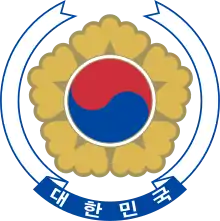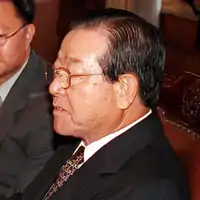1996 South Korean legislative election
Legislative elections were held in South Korea on 12 April 1996.[1] The result was a victory for the New Korea Party, which won 139 of the 299 seats in the National Assembly. Voter turnout was 63.9%. Although the New Korea Party remained the largest party in the National Assembly, it failed to win the majority.
| |||||||||||||||||||||||||||||||||||||||||||||||||||||||||||||||||
All 299 seats in the National Assembly 150 seats needed for a majority | |||||||||||||||||||||||||||||||||||||||||||||||||||||||||||||||||
|---|---|---|---|---|---|---|---|---|---|---|---|---|---|---|---|---|---|---|---|---|---|---|---|---|---|---|---|---|---|---|---|---|---|---|---|---|---|---|---|---|---|---|---|---|---|---|---|---|---|---|---|---|---|---|---|---|---|---|---|---|---|---|---|---|---|
| Turnout | 63.9% ( | ||||||||||||||||||||||||||||||||||||||||||||||||||||||||||||||||
| |||||||||||||||||||||||||||||||||||||||||||||||||||||||||||||||||
 |
|---|
| This article is part of a series on the politics and government of the Republic of Korea |
|
|
Parties
The governing New Korea Party (formerly the Democratic Liberal Party) of President Kim Young-sam, lost its absolute parliamentary majority. The election was held three years into President Kim's five year mandate.
The opposition National Congress for New Politics was formed by veteran opposition leader Kim Dae-jung and his supporters in the Democratic Party. Kim had retired from politics following his loss in the 1992 Presidential election but formed the new party after his return in 1995.
The right-wing United Liberal Democrats was led by former Prime Minister of South Korea Kim Jong-pil, a former ally of President Kim. He had been a member of the former ruling Democratic Liberal Party but broke with it after Kim's victory in 1992. It joined with Kim Dae Jung's opposition and formed coalition.
The United Democratic Party had once been the premier opposition party. It supported Kim Dae-jung's unsuccessful Presidential campaign in 1992 and was the largest opposition party in the outgoing National Assembly. However, following the defection of Kim and his supporters, the party was reduced to a minor force. It later merged to Kim's party.
Results
| Party | Votes | % | Seats | ||||
|---|---|---|---|---|---|---|---|
| FPTP | PR | Total | +/– | ||||
| New Korea Party | 6,783,730 | 34.5 | 121 | 18 | 139 | –10 | |
| National Congress for New Politics | 4,971,961 | 25.3 | 66 | 13 | 79 | New | |
| United Liberal Democrats | 3,178,474 | 16.2 | 41 | 9 | 50 | New | |
| United Democratic Party | 2,207,695 | 11.2 | 9 | 6 | 15 | –83 | |
| Unified People of Non-faction Party | 177,050 | 0.9 | 0 | 0 | 0 | New | |
| Great Korean Democratic Party | 3,114 | 0.0 | 0 | 0 | 0 | New | |
| 21st Century Korean Independence Party | 1,693 | 0.0 | 0 | 0 | 0 | New | |
| Chinmin Party | 571 | 0.0 | 0 | 0 | 0 | New | |
| Independents | 2,328,785 | 11.8 | 16 | 0 | 16 | –5 | |
| Invalid/blank votes | 469,726 | – | – | – | – | – | |
| Total | 20,122,799 | 100 | 253 | 46 | 299 | 0 | |
| Registered voters/turnout | 31,488,294 | 63.9 | – | – | – | – | |
| Source: Nohlen et al. | |||||||
Results by city/province
| Region | Total seats |
Seats won | ||||
|---|---|---|---|---|---|---|
| New Korea | National Congress | ULD | UDP | Ind. | ||
| Seoul | 47 | 27 | 18 | 0 | 1 | 1 |
| Busan | 21 | 21 | 0 | 0 | 0 | 0 |
| Daegu | 13 | 2 | 0 | 8 | 0 | 3 |
| Incheon | 11 | 9 | 2 | 0 | 0 | 0 |
| Gwangju | 6 | 0 | 6 | 0 | 0 | 0 |
| Daejeon | 7 | 0 | 0 | 7 | 0 | 0 |
| Gyeonggi | 38 | 18 | 10 | 5 | 3 | 2 |
| Gangwon | 13 | 9 | 0 | 2 | 2 | 0 |
| North Chungcheong | 8 | 2 | 0 | 5 | 0 | 1 |
| South Chungcheong | 13 | 1 | 0 | 12 | 0 | 0 |
| North Jeolla | 14 | 1 | 13 | 0 | 0 | 0 |
| South Jeolla | 17 | 0 | 17 | 0 | 0 | 0 |
| North Gyeongsang | 19 | 11 | 0 | 2 | 1 | 5 |
| South Gyeongsang | 23 | 17 | 0 | 0 | 2 | 4 |
| Jeju | 3 | 3 | 0 | 0 | 0 | 0 |
| Constituency total | 253 | 121 | 66 | 41 | 9 | 16 |
| PR list | 46 | 18 | 13 | 9 | 6 | 0 |
| Total | 299 | 139 | 79 | 50 | 15 | 16 |
Notes
- Combined total of the Democratic Party and the New Political Reform Party, which had merged in 1995 to form the United Democratic Party.
References
- Dieter Nohlen, Florian Grotz & Christof Hartmann (2001) Elections in Asia: A data handbook, Volume II, p420 ISBN 0-19-924959-8
External links
- 1996 elections in South Korea Inter-Parliamentary Union

.png.webp)
